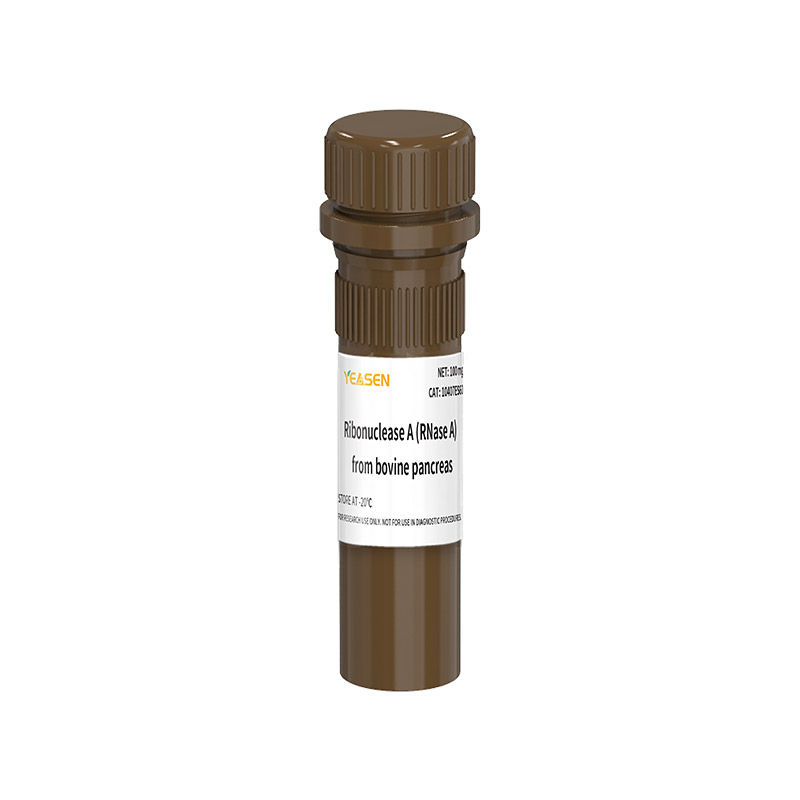Ribonuclease A (RNase A) from bovine pancreas
Product Description
Ribonuclease A (RNase A) is a single-stranded polypeptide containing 4 disulfide bonds with a molecular weight of about 13.7 kDa. As an endoribonuclease, it can specifically degrade cytosine (C) or uracil (U) residues on single-stranded RNA. Specifically, the cleavage recognizes the phosphodiester bond formed by the 5'-ribose on a nucleotide and the phosphate group on the 3'-ribose of the adjacent pyrimidine nucleotide, so that the 2', 3' - Cyclic phosphates are hydrolyzed to the corresponding 3'-nucleoside phosphates (eg, pG-pG-pC-pA-pG is cleaved by RNase A to generate pG-pG-pCp and A-PG).
RNase A is the most active in cleaving single-stranded RNA and is active in a variety of reaction conditions: at low salt concentrations (0 to100 mM NaCl), it can be used to cleave single-stranded RNA, double-stranded RNA, and RNA strands in RNA-DNA hybrids. while at high salt concentrations (≥0.3 M), RNase A can specifically cleave single-stranded RNA.
RNase A is most commonly used to remove RNA during the preparation of plasmid DNA or genomic DNA. Whether or not DNase is active during the preparation process can easily affect the reaction. The traditional method of boiling in a water bath can be used to inactivate DNase activity. In addition, this product can also be used in molecular biology experiments such as RNase protection analysis and RNA sequence analysis.
Product Information
|
CAS# |
9001-99-4 |
|
Appearance |
white powder |
|
Molecular Weight |
~13.7 kDa |
|
Optimal pH |
7.6 (Active range 6-10) |
|
Optimal temperature |
60℃ (Active range 15-70℃) |
|
Activator |
Sodium, Potassium, etc. |
|
Inhibitor |
Nuclease inhibitor |
|
Inactivation |
Heating will not inactivate, it is recommended to use spin column or phenol/chloroform extraction to fully remove. |
|
Source |
Bovine pancreas |
|
Solubility |
Dissolved in water (10 mg/mL) |
|
Loss on drying |
≤5.0% |
|
Activity |
≥60 Kunitz units/mg |
|
Isoelectric point |
9.6 |
Shipping and Storage
The product is shipped with ice packs and can be stored at -20℃ for two years.
Cautions
1. This product has been treated to remove DNase contamination during the production process. For the application of conventional plasmid DNA or genomic DNA extraction (no need to strictly quantify the level of DNA), high temperature boiling is not required, and the mother liquid can be directly prepared. For experiments that require strict control of DNase residues, it is recommended to boil at high temperature or purchase DNase-free, protease-free RNase A.
2. RNase A will be strongly adsorbed on glassware, so it is recommended to pack the solution into a plastic microcentrifuge tube.
3. For researchers operating RNA experiments, it is important to beware of RNase A introduction interfering with the accuracy of the experimental results.
4. For your safety and health, please wear lab coats and disposable gloves for operation.
5. This product is for research use ONLY!
Stock solution preparation
[Note]: This is one of the common methods for the preparation of RNase A stock solutions, but other methods can also be used according to the traditional laboratory method, or according to the literature (such as directly dissolved in 10 mM Tris-HCl, pH 7.5; or Tris-NaCl solution).
1. Prepare a 10 mg/mL RNase A stock solution using 10 mM sodium acetate (pH 5.2);
2. Heat at 100℃ for 15 min;
3. Cool to room temperature and add 1/10 volume of 1 M Tris-HCl (pH 7.4) to adjust the pH value to 7.4 (for example, 5 mL of 10 mg/mL RNase stock solution add 500 μL of 1 M Tris-HCl, pH 7.4);
4. Aliquot and store at -20℃ and can be stored stably for up to 2 years.
[Note]: Boiling RNase A solution at neutral conditions will result in RNase precipitate formation; boil it at a lower pH, and precipitation may be observed, possibly due to the presence of protein impurities. If precipitation is found after boiling, the impurities can be removed by high-speed centrifugation (13,000 rpm), and then frozen in aliquots.
Catalog No.:*
Name*
phone Number:*
Lot:*
Email*
Country:*
Company/Institute:*
Recommended products

